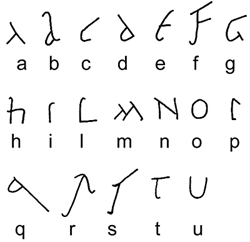
Click on the image for a larger version. |
Image
details:
Some of the commonest forms of letters in
the Vindolanda ink tablets
Image ownership:
© CSAD |
This page presents three exercises in reading the script of the
Vindolanda tablets as an informal introduction to gaining greater
familiarity with the script. They use images of three well-preserved
tablets, including two letters and an address. In the images of
the whole or part tablets each line of text is separated. Transcribe
each line on paper and then check your transcription against the
editors’ reading by clicking the 'show transcription' button.
As far as possible the letters of the editor’s readings are
placed directly below the corresponding letter in the tablet. Uncertain
letters are rendered smaller, raised above the line and followed
by a question mark. Supplied letters are enclosed in square brackets
and symbols or abbreviations are expanded in brackets.
Tablet 299
299 is part of a letter to Lucius, a decurion, reporting the gift
of 50 oysters. This is one of the clearest examples of handwriting
in the tablets, with neat letters formed with thick strokes. Individual
letters are often joined by ligatures, for example cus
in amicus in the third line. Words are frequently separated
by spaces, an unusual feature among the tablets.
Tablet 260
This image illustrates the layout of addresses and the ‘spindly’
version of the script in which addresses were written on the backs
of letters. This address records the name of the addressee, Flavius
Cerialis, and the sender, Iustinus, presumably also a prefect since
he styles himself collega. Cerialis’ title, praefectus,
is more commonly written on a separate line from the name. Medial
points after coh and col indicate the presence
of abbreviations.
Tablet 291
This letter contains two hands, the elegant right sloping hand
in which most of the letter is written and the hand of the closing
greeting. The image shows the first lines written by the first hand.
The end of the first line is missing and the small remnant of the
second line is difficult to read and is not included in the transcription.
The two lines can however be reliably reconstructed and read in
full Cl(audia) Seuera Lepidinae suae salutem. The document
includes oblique marks over some vowels, for example the a
of Seuera in the first line. This first hand is presumably
that of the scribe, the second hand (not shown here) is presumably
that of Severa herself , the
earliest preserved example of a woman’s handwriting in Latin.
|